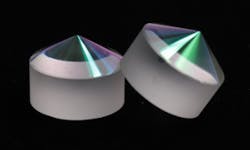Axicon Lens
Axicon Lens Introduction
An axicon lens is a special lens with one plano (flat) surface and one conical surface. Also known as a rotationally symmetric prism, an axicon lens creates a focal line along the optical axis using interference, and can convert a laser beam into a ring shaped beam of light. Axicons are typically defined by their apex angles.
At Shanghai Optics we produce high-precision axicon lenses for medical, scientific and industrial applications. From eye surgery to optical tweezers to laser drilling, from optical coherence tomography to particle physics, these prisms play a very important role in a wide range of optical systems.
Understanding Axicon Lenses
To convert a collimated beam of light into a ring, one places the axicon lens with the flat side facing the collimated beam. Light enters at a perpendicular angle, in the center of this flat side, then travels along the axions optical axis and and leaves the lens as a cone of light. When projected onto a planar surface this light can be seen to be a ring. The closer the surface, the smaller the diameter of the ring.
While a Gaussian beam would deteriorate over distance, the beam profile produced by an axicon begins by nearly propagating the properties of a Bessel beam which maintains a stable intensity distribution as it propagates. In fact, it generates a very good approximation within its depth of focus, which can be calculated from the radius of the beam entering the axicon, the index of refraction of the axicon, and the angle α. If the angle of refraction is small, this can be approximated by radius/ (index of refraction-1) α.
Beyond the depth of focus, an axicon lens produces a uniform ring-shaped beam.
Creation of Bessel beams through an axicon lens
Applications of an Axicon Lens
One application of axicons is in what is called optical trapping. This technique involves creating attractive and repulsive forces by means of a laser, then using these forces to mover or trap very small particles (micro particles) and, on occasion, cells. An axicon lens, forming a Bessel beam within the DOF (depth of focus, the beam overlap region), can effectively trap a particle on a flat surface such as a microscope slide.
Axicon lenses are also used for optical surgery, enabling the surgeon to focus in on an area of interest and to smooth tissue where necessary. For ultimate adjustability of ring diameter a combination of positive and negative axions are often used for this application.
In telescopes, lenses are used as solar concentrators to focus the light from the sun. In optical coherence tomography (OCT), they are used for laser drilling and optical trepanning.
A reflective axicon, also known as a reflaxicon, does not have the geometry of a traditional axicon. Rather, it consists of a pair of coaxial conical reflective surfaces. Designed to manipulate light in much the same manner of a transmissive axicon, it has several features that make it the best choice in some situations: a high damage threshold, low chromatic aberration, and better group velocity dispersion.
Axicon Lenses at Shanghai Optics
At Shanghai Optics we produce a variety of axicon lenses from optical materials such as fused silica, sapphire, ZnSe, and plastics. Our lenses can be made with almost any ring diameter, and both refractive and diffractive axicon lenses are available. We can also design optical assemblies such as a combination of axicons with beam expanders, lenses, or additional axions to produce your desired beam profile.






